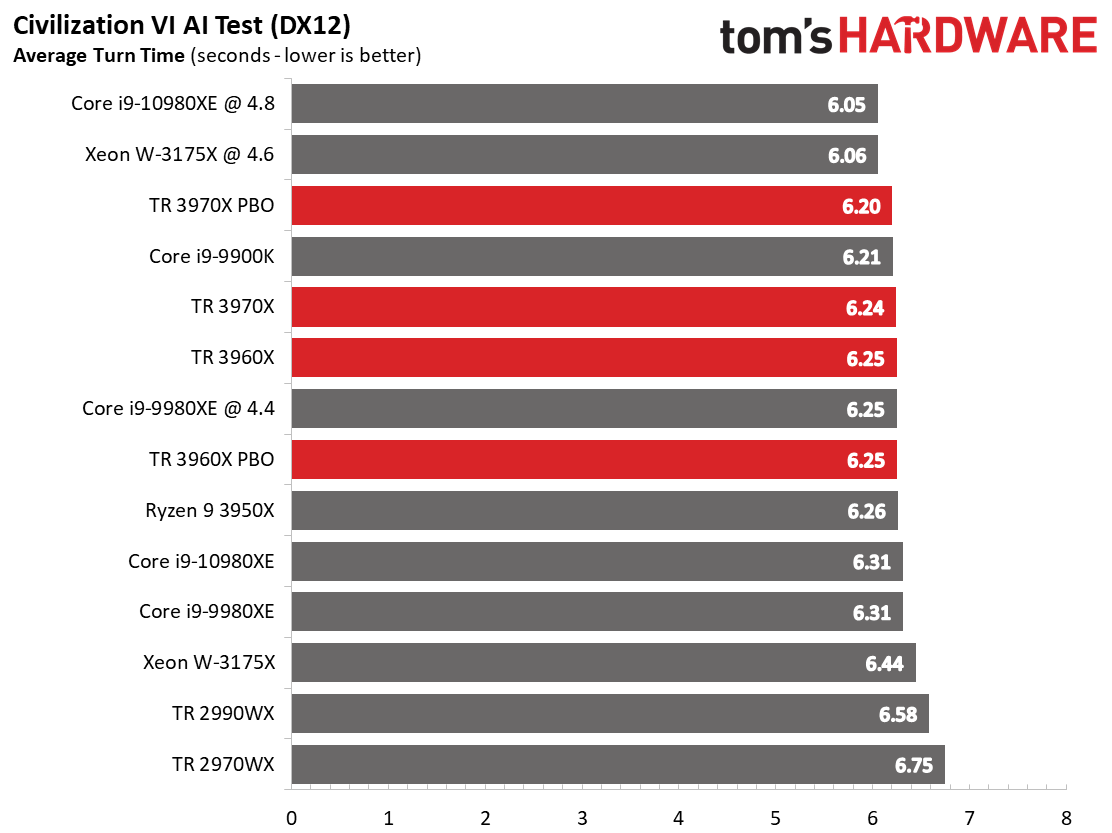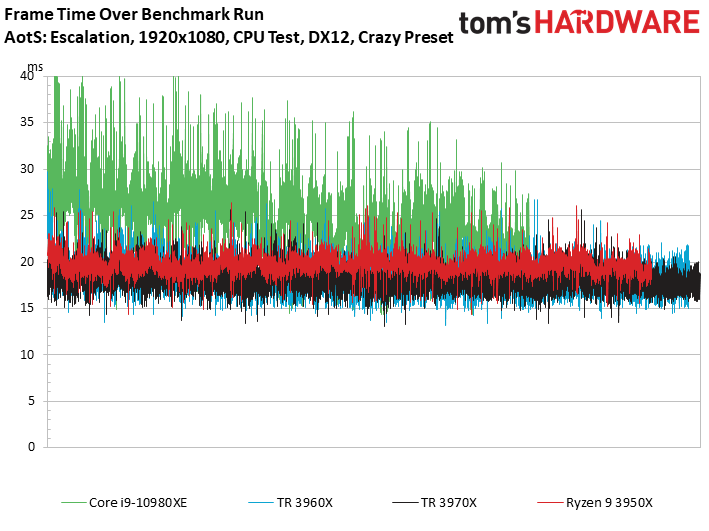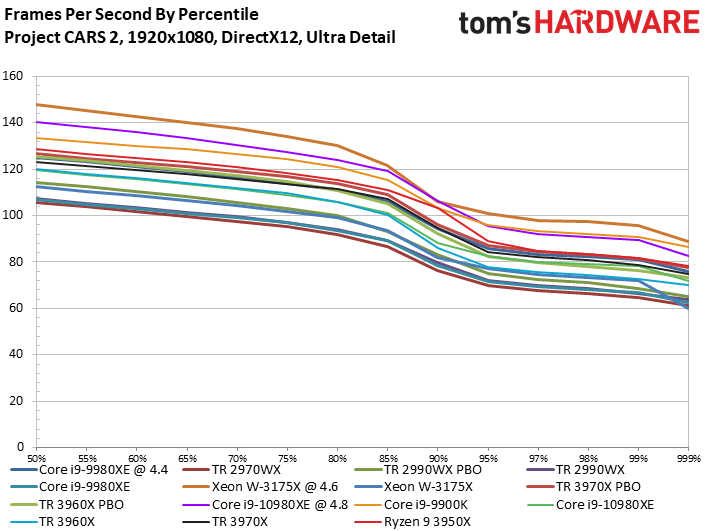Why you can trust Tom's Hardware
Test Notes
All AMD entries with "PBO" indicate an auto-overclocked configuration paired with with DDR4-3600. Intel's overclocked configurations also use DDR4-3600.
AMD designed the Threadripper 3970X and 3960X for prosumer-class applications, but it still comes with a Game Mode preset in the Ryzen Master software that disables three of the four available dies (1/4). This feature debuted with the first-gen Threadripper processors to improve gaming performance and ensure compatibility with some games.
AMD says this feature largely isn't needed anymore, although there are a few titles that aren't compatible with the copious helping of threads. Far Cry 5 notoriously struggles with high core counts, and we also noticed abnormally low performance and outwardly rough gameplay in Dawn of War: Warhammer. As such, we tested those titles in Game Mode with the 3970X and 3960X, but we tested the remainder of the games in the standard Creator Mode (all cores/threads active).
The second-gen Threadripper models still suffer from the same odd performance in games if we leave all cores active, so we tested the Ryzen Threadripper 2990WX and 2770WX in game mode for all gaming tests.
Given Threadripper 3000's high-priced nature, we fully expect these processors to be paired with high-resolution QHD (and beyond) displays. However, in keeping with our standard practice, we test at the FHD resolution to eliminate graphics-imposed bottlenecks. Be aware: These deltas will shrink at higher gaming resolutions.
VRMark and 3DMark



The 3DMark DX12 and DX11 tests measure the amount of raw horsepower exposed by the processor to game engines, but most game engines don't scale as linearly with additional compute resources.
The DX12 tests expose the huge step forward with the Threadripper 3000 as the chips easily outpace their predecessors. However, we can see this workload doesn't scale as linearly as we'd like with extra cores: The 24-core 48-thread 3960X outpaces the 32C/64T 3970X at both stock and overclocked settings, and easily outpaces the stock Cascade Lake-X Core i9-10980XE. However, Intel's new flagship turns the tables after overclocking.
Get Tom's Hardware's best news and in-depth reviews, straight to your inbox.
The DX11 tests also don't scale as well with additional cores, though we do see the expected gains with overclocking.
VRMark responds well to high per-core performance, but the Threadripper 3000 processors challenge Intel's finest HEDT chips: They both beat the HEDT competitors at stock settings.
Intel's W-3175X takes the overall lead after we dial up the clocks, but bear in mind this is an exotic $3,000 chip that requires extremely extravagant accommodations.
Civilization VI AI and Stockfish


The Civilization VI AI test measures AI performance in a turn-based strategy game and is heavily influenced by high clock rates and instruction per cycle (IPC) throughput.
The top of these charts used to be Intel-only territory, but AMD has made amazing gains in per-core performance (a mixture of IPC and frequency) with the Zen 2 microarchitecture. Despite its hefty core counts, the Threadripper 3970X features the same boost clock as the 3960X, but it's premium silicon might be able to attain those boosts and stay at those heightened speeds for longer periods. Here we can see the 3970X beat the 3960X, if only by the slimmest of margins, and also experience additional uplift from the auto-overclocking feature. Intel's HEDT chips trail at stock settings, but once again take the lead after tuning.
The open-source Stockfish AI chess engine is the polar opposite of the Civilization VI engine. This engine is designed specifically for many-core chips and scales well up to 512 cores, which is music to Threadripper's ears. At stock settings, the 3970X leads convincingly while the overclocked W-3175X struggles to keep pace. The 3960X once again doesn't see much uplift from overclocking, but it effectively ties the W-3175X at stock settings.
Keep your eyes on the previous-gen Threadripper models as you flip through the charts. AMD's explosive gen-on-gen performance improvement, borne of a new architecture and manufacturing process, is impressive.
Meanwhile in this test, the Cascade Lake-X i9-10980XE either ties or falls behind its predecessor, the -9980XE, at stock settings.
Ashes of the Singularity: Escalation



Ashes of the Singularity: Escalation responds well to extra cores and threads, which benefits the Ryzen lineup. Intel's -10980XE suffers from a erratic frame latency during our test, and we tested multiple times and reinstalled the game/drivers in an attempt to rectify the issue. However, the condition is repeatable and carries over to the overclocked configuration, too. As we can see, this results in a lower 99th percentile frame rate, but that same trend applies to the W-3175X and the -9980XE. We theorize this stems from Intel's mesh architecture, present only on Intel's HEDT and data center processors, which can negatively impact performance with unoptimized software. It's also possible the issue is exacerbated by an early firmware revision for the refreshed X299 platform, or a lack of driver/game engine tuning.
Overclocking helps, but the -10980XE at 4.8 GHz trails the previous-gen -9980XE at 4.6 GHz. The overclocked W-3175X blasts to the top of the chart but its 99th percentile frame rates trail the 3970X.
Meanwhile, the Threadripper processors are a solid generational step forward. As you can see at the bottom of the chart, the second-gen Threadripper chips aren't the best solution for gaming due to the eccentricities of their multi-die design. In contrast, Threadripper 3000 beats the stock Intel processors.
Civilization VI Graphics Test



The Civilization VI graphics test finds the stock Ryzen 9 3950X delivering excellent performance given its price point. That reminds us that these HEDT processors aren't the best fit for gamers – most enthusiasts are better served by mid-range and high-end mainstream chips.
Intel's overclocking advantage comes into play once again, with the Core i9-10980XE taking a convincing lead. The stock Threadripper 3000 chips continue to impress, and the auto-overclocking PBO feature ekes out a few extra fps.
Dawn of War III



It isn't surprising to see the overclocked Intel HEDT chips take the top of the Dawn of War III chart due to their per-core performance advantage. Again we see Threadripper 3000's big leap forward over the previous-gen models, but the gains from overclocking are muted.
Intel's HEDT chips can suffer from their unique architecture in some game titles, but that same trend applies to the Threadripper processors, too. AMD's first- and second-gen Threadripper models were known for their erratic performance that stems from unoptimized game engines, necessitating a game mode that effectively removes cores and threads to boost performance. That trend doesn't plague Threadripper 3000 models as much, but there are exceptions. As a result, we tested the 3970X and 3960X in game mode for this title. You can see the difference in performance in the table below.
| Dawn of War III | Threadripper 3970X | Threadripper 3960X |
| Creator Mode fps | 95.1 | 95.3 |
Far Cry 5



Intel's -9900K leads the pack, and overclocking would open an even larger divide. The -10980XE is also particularly impressive after overclocking, but the 3970X is faster at stock settings.
As you can see in the table below, Far Cry 5's unoptimized code incurs a big performance penalty when all cores and threads are exposed to the operating system (creator mode), so we also tested this title in game mode.
| Far Cry 5 | Threadripper 3970X | Threadripper 3960X |
| Creator Mode fps | 82.8 | 96.9 |
It's noteworthy that similar adjustments might also benefit Intel's high core-count processors, but the company hasn't made an easy-to-use tool to reduce core counts. AMD has instituted the ability to switch between game mode and creator mode in its Ryzen Master software, but it requires a reboot, so we still think it is an inconvenient band-aid.
Final Fantasy XV



We run this test with the standard quality preset to sidestep the impact of a bug that causes the game engine to render off-screen objects with the higher-resolution setting.
Intel's HEDT chips flex their gaming muscle when the game engine cooperates. Here the chips take the lead across the board at both stock and overclocked settings, pushing us close to a graphics-imposed bottleneck.
Grand Theft Auto V



Grand Theft Auto V continues to be popular six long years after its release. This title favors Intel architectures and, more generally, multi-core designs with high clock rates. Intel's chips lead across the board in this title, and we spot a few significant outliers from both Threadripper 3000's and the Intel -10980XE that manifested as hitching during the benchmark sequence.
Hitman 2



The Threadripper 3000 processors are competitive against Intel's processors at stock settings, but don't experience as much explosive uplift from overclocking. The Core i9-10980XE is impressive after tuning, nearly matching the W-3175X.
Project Cars 2



Project Cars 2 is optimized for threading, but high clock rates pay off. As expected, that results in a win for Intel's overclocked processors. The 3970X leads the -10980XE at stock settings, while the 3960X is competitive. The Core i9-9900K is also impressive, and overclocking it would hand it the unequivocal win in this title.
World of Tanks enCore



AMD has addressed the lions share of the erratic gaming performance we observed with previous-gen models, but Intel's chips are beastly overclockers.
MORE: Best CPUs
MORE: Intel & AMD Processor Hierarchy
MORE: All CPUs Content
Current page: Threadripper 3970X Gaming
Prev Page Boost Speeds, Power Consumption, Test Setup Next Page Threadripper 3970X SPEC Workstation and Adobe Performance
Paul Alcorn is the Editor-in-Chief for Tom's Hardware US. He also writes news and reviews on CPUs, storage, and enterprise hardware.
-
Vrooman By default, Numpy and Scipy in Python are compiled with Intel's MKL. This math library provides excellent results with Intel CPUs but quite poor results with AMD. Changing the compile flag to use OpenBlas math library provides significant speedups ( sometimes on the order of 100% ) with AMD processors in Numpy and Scipy. This has been reported fairly often in Puget Systems & Phonorix processor reviews and I've personally seen it in my 3900x use. Just a note I thought would be useful to point out ( as I'm not sure this is addressed in the review )Reply -
g-unit1111 Kind of unfair that the 3175X gets lumped in that category since it's nearly 3 times as expensive as the other CPUs included in the benchmark and has almost double the cores and threads. It's like comparing a Bentley Flying Spur to a Nissan Maxima.Reply -
delaro That is a massive amount of cores and threads that are twiddling their combined thumbs when your gaming. I'm surprised this review focused so much on that aspect. This isn't the kind of chip you buy for that use, this is the kind of chip you buy to make the games.:unsure:Reply -
AC5L4T3R 3950x currently on sale for 850 euros in Germany compared to 1550 for the 3960x. Really struggling to justify paying almost twice as much when theres nowhere near twice as much performance.Reply -
larkspur Reply
Huh? We're comparing high-end CPUs here. Most of the folks buying a threadripper are using it for professional purposes. Why wouldn't we include other high-end CPUs used for professional purposes? The 3175X isn't even the most expensive chip listed. The inclusion of a Ryzen 3950x is a nice comparison for those deciding whether the extra ~$1250 for the 3970x or ~$650 for the 3960x makes sense (not including platform costs). Just as the inclusion of the Intel 3175X helps to decide whether another ~$1000 makes sense to go with a somewhat comparable Intel. In the professional world these price differences aren't nearly as large as they seem. Time=money.g-unit1111 said:Kind of unfair that the 3175X gets lumped in that category since it's nearly 3 times as expensive as the other CPUs included in the benchmark and has almost double the cores and threads. It's like comparing a Bentley Flying Spur to a Nissan Maxima.
Still upset about abandoning TR4 but I know, I know. That's how it goes... <sigh> oh well :( -
RodroX Why not use a pci-e 4.0 nvme SSD for the tests?Reply
And why having to buy a new Mobo is a Con? Is the only way to support for PCI-E 4.0. This is not a consumer chip, so not having backward motherboard compatibility is not really an issue. -
larkspur Reply
Well, ultimately you're right, it's not a dealbreaker. It's just a PiTA - swapping a CPU is relatively quick. Swapping out an entire mobo + fresh OS and software install takes a lot more time. Like I said, you're right it's not a dealbreaker, but it would have been nice to get a Zen 2 chip in a TR4 mobo.RodroX said:And why having to buy a new Mobo is a Con? Is the only way to support for PCI-E 4.0. This is not a consumer chip, so not having backward motherboard compatibility is not really an issue. -
TJ Hooker Reply
For the same reason that it's nice that Ryzen 3000 chips work on pre-X570 motherboards: it's nice to have that option. The new chips are still attractive options even without PCIe 4.0.RodroX said:And why having to buy a new Mobo is a Con? Is the only way to support for PCI-E 4.0. -
RodroX ReplyTJ Hooker said:For the same reason that it's nice that Ryzen 3000 chips work on pre-X570 motherboards: it's nice to have that option. The new chips are still attractive options even without PCIe 4.0.
I know that, heck I have an R5 3600 runing on inexpensive B450 mobo. But if you swap pins around, and you don't have extra ones like it seems AMD had to accomodate the pci-4 support on AM4 socket for its consumer chips, then theres no much you can do right?
Its nice to have, but I still wont think is a Con.